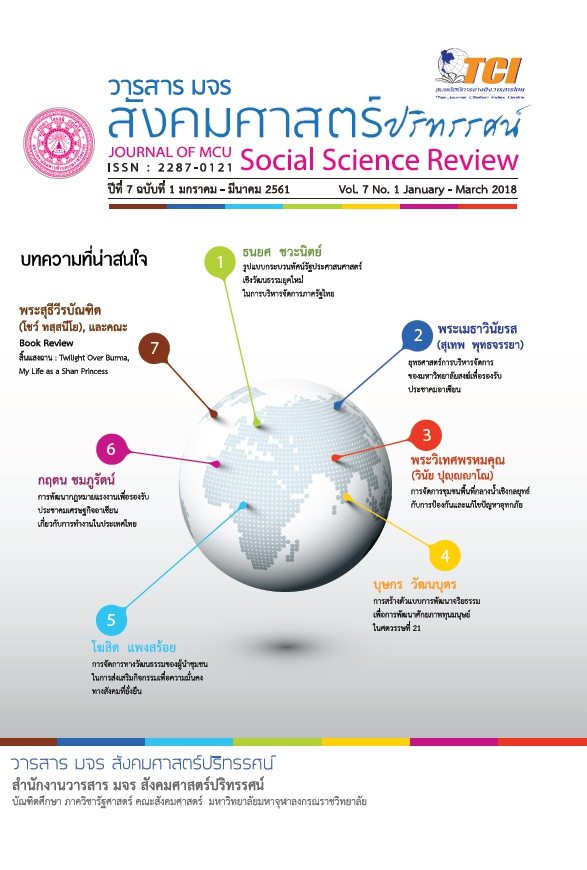รูปแบบกระบวนทัศน์รัฐประศาสนศาสตร์เชิงวัฒนธรรม
คำสำคัญ:
กระบวนทัศน์, รัฐประศาสนศาสตร์, วัฒนธรรมบทคัดย่อ
บทความนี้มีวัตถุประสงค์ 1) เพื่อศึกษาการก่อเกิดและสาเหตุของการเปลี่ยนแปลงกระบวนทัศน์รัฐประศาสนศาสตร์ 2) เพื่อค้นหารูปแบบกระบวนทัศน์รัฐประศาสนศาสตร์เชิงวัฒนธรรม และ
3) เพื่อนำเสนอรูปแบบกระบวนทัศน์รัฐประศาสนศาสตร์เชิงวัฒนธรรม
การศึกษาวิจัยครั้งนี้ ใช้ระเบียบวิธีวิจัยเชิงคุณภาพ โดยการสัมภาษณ์เชิงลึกแบบมีโครงสร้างเก็บข้อมูลจากข้าราชการสำนักงานคณะกรรมการพัฒนาระบบราชการ สำนักนายกรัฐมนตรี จำนวน 21 คนและข้าราชการกรมส่งเสริมวัฒนธรรม กระทรวงวัฒนธรรม จำนวน 5 คน และการสนทนากลุ่มเฉพาะจำนวน 9 รูป/คน ผู้วิจัยใช้วิธีการวิเคราะห์ข้อมูลการศึกษาเชิงเอกสารจากเอกสาร ตำรา แนวคิด ทฤษฎีและผลงานวิจัยที่เกี่ยวข้อง วิเคราะห์ข้อมูลการสัมภาษณ์เชิงลึกจากผู้ให้ข้อมูลสำคัญที่ได้แสดงความคิดเห็น และวิเคราะห์ข้อมูลการสนทนากลุ่มเฉพาะจากผู้ทรงคุณวุฒิที่ได้เสนอแนะเพื่อนำไปกำหนดเป็นรูปแบบกระบวนทัศน์รัฐประศาสนศาสตร์เชิงวัฒนธรรม
ผลการวิจัยพบว่า
- การก่อเกิดและสาเหตุของการเปลี่ยนแปลงกระบวนทัศน์รัฐประศาสนศาสตร์
การก่อเกิดกระบวนทัศน์การจัดการภาครัฐแบบดั้งเดิม (Old Public Management: OPM) เกิดจากการนำระบบราชการในอุดมคติของ แมกซ์ เว็บเบอร์ (Max Webber) ที่เน้นเรื่อง กฎ ระเบียบ ข้อบังคับ ซึ่งต้องปฏิบัติตามทุกขั้นตอนเพื่อป้องกันความผิดพลาดและสามารถใช้ได้กับทุกองค์การ สาเหตุของการเปลี่ยนแปลงสู่กระบวนทัศน์การจัดการภาครัฐแนวใหม่ (New Public Management: NPM) เกิดจากระบบราชการมีโครงสร้างที่ใหญ่โต การแก้ปัญหาเป็นไปอย่างล่าช้า เกิดการทุจริตประพฤติมิชอบในการปฏิบัติราชการ ส่วนการก่อเกิดกระบวนทัศน์การจัดการภาครัฐแนวใหม่
(New Public Management: NPM) เกิดจากความต้องการแก้ปัญหาการทุจริตประพฤติมิชอบในระบบราชการ จึงนำระบบตลาดของภาคเอกชนมาใช้แก้ปัญหา พร้อมกับต้องการเพิ่มประสิทธิภาพ ประสิทธิผล และประหยัดโดยให้ภาคเอกชนดำเนินกิจการแทนรัฐในเรื่องที่ทำได้ดีกว่า สาเหตุของการเปลี่ยนแปลงสู่กระบวนทัศน์การบริการสาธารณะแนวใหม่ (New Public Service: NPS) เกิดจากการทำตัวเป็นผู้ประกอบการของเจ้าหน้าที่รัฐที่มุ่งแสวงหาประโยชน์ส่วนตนมากกว่าประโยชน์ของประชาชนส่วนรวม และการก่อเกิดกระบวนทัศน์การบริการสาธารณะแนวใหม่ (New Public Service: NPS) เกิดจากรากฐานประชาธิปไตยที่มองประชาชนเป็นพลเมืองเจ้าของประเทศไม่ใช่ลูกค้าที่มาขอรับบริการ
และมุ่งรับใช้ประชาชนมากกว่าการเป็นเจ้านาย
- 2. การค้นหารูปแบบกระบวนทัศน์รัฐประศาสนศาสตร์เชิงวัฒนธรรม ในงานวิจัยที่เป็นการนำวัฒนธรรมในการทำงานที่ดีงามมาแก้ปัญหาระบบราชการที่สำคัญๆ ได้แก่ 1) องค์การภาครัฐขาดความเข้มแข็ง 2) ข้าราชการขาดคุณธรรมจริยธรรม 3) การบริการขาดความพึงพอใจ และ 4) ข้าราชการขาดจิตสำนึกประชาธิปไตยและนำทศพิราชธรรมมาบูรณาการเพื่อเป็นแนวทางให้กับข้าราชการประพฤติปฏิบัติตนเป็นข้าราชการที่ดีของแผ่นดิน
- 3. รูปแบบกระบวนทัศน์รัฐประศาสนศาสตร์เชิงวัฒนธรรม
3.1 กระบวนทัศน์วัฒนธรรมเสริมสร้างความเข้มแข็งให้กับองค์การภาครัฐ หมายถึงรูปแบบการปฏิบัติงานของข้าราชการที่ทำให้องค์การภาครัฐเกิดความเข้มแข็ง ประกอบด้วย 1) ไม่ทุจริตทุกรูปแบบ 2) เสียสละเพื่อประโยชน์ส่วนรวม 3) สามัคคี 4) มีวิสัยทัศน์ 5) เป็นผู้นำการเปลี่ยนแปลง และ 6) กล้าตัดสินใจในสิ่งที่ถูกต้อง และทศพิธราชธรรม ได้แก่ อาชชวะ ปริจจาคะ และศีล
3.2 กระบวนทัศน์วัฒนธรรมเสริมสร้างคุณธรรมจริยธรรมให้กับข้าราชการ หมายถึงรูปแบบการปฏิบัติงานของข้าราชการที่ทำให้มีคุณธรรมจริยธรรมสูงขึ้นประกอบด้วย การรอบรู้ในหน้าที่และปฏิบัติตามประมวลจริยธรรมองค์การอย่างเคร่งครัด และทศพิธราชธรรม ได้แก่ อาชชวะ อวิหิงสา
อวิโรธนะ และทาน
3.3 กระบวนทัศน์วัฒนธรรมเสริมสร้างความพึงพอใจให้กับประชาชน หมายถึง รูปแบบการปฏิบัติงานของข้าราชการที่ตอบสนองความต้องการของประชาชนโดยส่วนรวมประกอบด้วยการบริการที่ดีและตรงความต้องการที่แท้จริงของประชาชน และทศพิธราชธรรม ได้แก่ อาชวะ มัททวะ และอักโกธะ
3.4 กระบวนทัศน์วัฒนธรรมเสริมสร้างประชาธิปไตยให้กับข้าราชการ หมายถึง รูปแบบการปฏิบัติงานของข้าราชการตามแนวทางประชาธิปไตยประกอบด้วย 1) ความศรัทธาเชื่อมั่นในระบอบประชาธิปไตย 2) การเคารพสิทธิเสรีภาพซึ่งกันและกัน และ 3) การเคารพความเสมอภาคและทศพิธราชธรรม ได้แก่ ตปะ ขันติ และอวิหิงสา
เอกสารอ้างอิง
Chaiwut Warapin. (2014). attributes of the modern leadership with professional management competencies of municipal clerks in the central region. journal of the association of researchers, 19 (1), 91.
Jagraval Sukmaitree. (2016). organizational culture based on sangkahavattu 4. journal of mcu social science review, 5 (2), 147-148.
Jakrapan Chooklin. (2015). relationship between leadership and power expertise of school administrators under the krabi primary educational service area office. stou education journal, 8 (1), 105.
Nattawut Kaewbangpood. (2011). the relationship between transformational leadership and organizational culture: a case study of the phuket town municipality. academic services journal, 22 (1), 95.
Paramut Wanbowon. (2016). creating political culture with citizen for democratic regime. journal of mcu social science review, 5 (3), 267.
Phra Kan Kantadhammo. (Saengrung). (2015). the development of good citizenship in buddhist perspectives. liberal arts review, 11 (21), 48.
Pornamrin Promgird. (2014). political culture and democracy development in north-east rural community area: a case study of people in khambong and sa-ard village, ampure nampong, khon kaen province. humanities & social sciences journal, 31 (3), 76.
Somjai Nhoorit. (2014). performance of service in tambon health promoting hospital, the study of phattalung provincial region 11. medical journal, 8 (2), 477.
Thasanee Chuadung. (2009). a study of effective leadership components of head nurses, government university hospitals. thai journal of nursing council, 24 (4), 51.
Udom Ratamarit. (2003). political and bureaucratic corruption and its solution. bangkok: the secretariat of the house of representatives.
ดาวน์โหลด
เผยแพร่แล้ว
รูปแบบการอ้างอิง
ฉบับ
ประเภทบทความ
สัญญาอนุญาต
ลิขสิทธิ์ (c) 2019 วารสาร มจร สังคมศาสตร์ปริทรรศน์

อนุญาตภายใต้เงื่อนไข Creative Commons Attribution-NonCommercial-NoDerivatives 4.0 International License.
เพื่อให้เป็นไปตามกฎหมายลิขสิทธิ์ ผู้นิพนธ์ทุกท่านต้องลงลายมือชื่อในแบบฟอร์มใบมอบลิขสิทธิ์บทความให้แก่วารสารฯ พร้อมกับบทความต้นฉบับที่ได้แก้ไขครั้งสุดท้าย นอกจากนี้ ผู้นิพนธ์ทุกท่านต้องยืนยันว่าบทความต้นฉบับที่ส่งมาตีพิมพ์นั้น ได้ส่งมาตีพิมพ์เฉพาะในวารสาร มจร สังคมศาสตร์ปริทรรศน์ เพียงแห่งเดียวเท่านั้น หากมีการใช้ภาพหรือตารางหรือเนื้อหาอื่นๆ ของผู้นิพนธ์อื่นที่ปรากฏในสิ่งตีพิมพ์อื่นมาแล้ว ผู้นิพนธ์ต้องขออนุญาตเจ้าของลิขสิทธิ์ก่อน พร้อมทั้งแสดงหนังสือที่ได้รับการยินยอมต่อบรรณาธิการ ก่อนที่บทความจะได้รับการตีพิมพ์ หากไม่เป็นไปตามข้อกำหนดเบื้องต้น ทางวารสารจะถอดบทความของท่านออกโดยไม่มีข้อยกเว้นใดๆ ทั้งสิ้น





